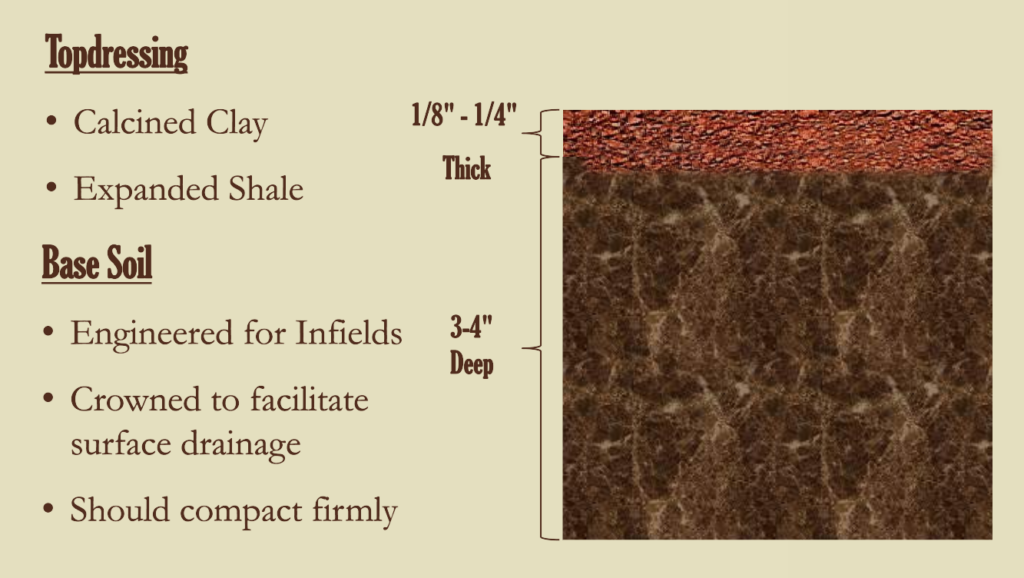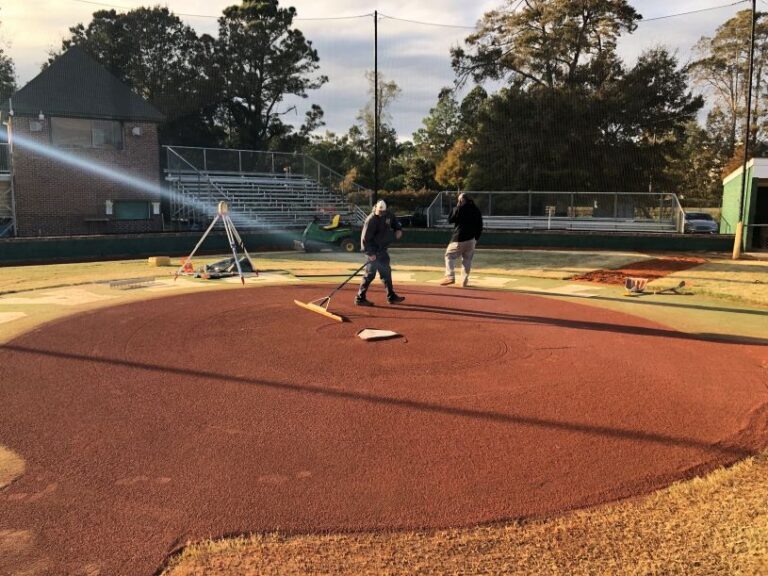By Luke Yoder and Paul Zwaska
Back in the 1960s, groundskeepers began incorporating different products into their infield skins to try to improve playability. These products were initially produced for the golf and automotive industries, and consisted of diatomaceous earth, porous ceramics and even crushed corn cobs. They were referred to as amendments or conditioners because the products were typically blended into the infield profile.
By the 1980s, calcined clays became the primary product to apply to infields, either by tilling in as an amendment or applying across the surface as a topdressing. Utilizing the calcined clay on the surface improved the sliding surface, provided a buffer between the infield mix and the athlete’s feet, and improved moisture management.
In 1990, vitrified clay topdressing was introduced to the sports field management industry as an infield amendment. The clay product was baked much hotter than calcined clay, which ultimately changed its water absorption capabilities. What you had was a harder particle that absorbed much less water than calcined clays. These vitrified clays only lasted for 10 to 15 years and were eventually replaced by expanded shale, which acted very similarly to the vitrified products, except they were even more durable. The changing landscape of these products during that period left many groundskeepers confused as to what to do with their fields. It took some time for end users to understand the benefit, as there was little to no research during that 30-year span to guide the field managers in the application of these various products on their infields.
By the 1990s, the term “infield topdressing” became more prevalent terminology in the ballfield groundskeeper’s vocabulary. The practice of using these products strictly on the surface – not tilling into the infield soil profile – started to change the way infield skins were managed.
Today, calcined clay and expanded shale products now dominate the infield topdressing industry. Calcined clay, with a massive amount of pore space in the particle, can absorb its own weight in water. Expanded shale has very little absorption capacity, allowing more water into the infield skin and holding it there while it acts like a mulch on the infield skin surface. Shale’s heavier bulk density also slows its migration on the infield surface. The different attributes of calcined clay and expanded shale are subtle to some, but can provide solid maintenance options depending on climate and labor capacity.
In the past, the terms topdressing, conditioner and amendment were used interchangeably by manufacturers and field managers to describe multiple products. The practice of tilling into the profile of the infield skin to amend or condition was preached as gospel throughout the industry. Tilling in calcined clay was the solution to every possible problem on an infield – too hard, too soft, too dry, too wet, just till in calcined and all is good. There are obvious shortcomings with a one-size-fits-all solution to multiple problems. Tilling in calcined clay to improve a poor rootzone was a good idea and still is today.
It will increase pore space, relieve compaction, increase CEC, improve vertical drainage and encourage stronger rooting for a healthier happier turf plant. A good infield profile requires a totally different structure than a rootzone. A certain amount of compaction is essential, and, because of that, vertical drainage is virtually nonexistent. Horizontal or surface drainage is what saves games. Using calcined clay as a conditioner will compromise the structure, reduce the moisture holding capacity, and decrease the stability of the infield profile. Calcined clay, expanded shale, or a combination of both should only be applied to the top surface of your infield profile at an 1/8-inch depth (no more than ¼ inch) to improve the sliding surface and moisture management.

Using calcined clay and/or expanded shale as a topdressing has become recognized as a best management practice in recent decades. However, there are still stalwarts out there who cling to the old tilling method. Changing the process throughout an entire industry will not happen overnight. The use of the term “conditioner,” and the continuing message to use calcined clay and expanded shale as an “amendment” to improve your infield profile is still common. Recommendations of as much as 1,800 lbs./1,000 ft2 are still common. The question is how can calcined clay be marketed as a conditioner for both infield skin profiles and rootzones when the objective for the performance of each are opposite?
If your goal is to improve your infield soil, the best approach is based upon science. Collect and submit a soil sample to a professional laboratory for a particle size analysis. This is the blood test for infield skin material. The results will show the proportion of sand, silt and clay in the infield skin. At this point, adding the right soil as an amendment can alter the makeup of the soil and correct any deficiencies in its texture. This approach permanently modifies the soil and can be measured. Tilling calcined clay or expanded shale cannot correct the soil texture in ways that are beneficial to the performance of an infield skin.
One common issue with calcined clay is the breakdown of the particles due to the abrasive actions of dragging, rolling, normal play and other maintenance tasks. Expanded shale resists breakdown due to the natural hardness of the raw material which is further enhanced through the heating process of it during production of the product. When calcined clay does break down, it tends to turn to a powder that acts much like a silt layer on the surface of the infield. As this “silty” layer accumulates on the surface, it can create very dusty conditions when dry and slimy conditions when wet. At this point, the only fix is to remove the top ½- to 1 inch of contaminated material and replace it with new infield mix.
Research the calcined clay products available on the market to find the most durable. The quality of calcined clay increases as you increase the temperature at which it is baked. Those that are baked just enough to calcine it are subject to more rapid breakdown on the field surface than those that are baked to the upper end of the calcining process. Those calcined clays will be more durable and break down at a slower rate – and therefore last much longer on the infield surface. You will find there are sizable differences between the brands on the market.
Sports field managers should look at topdressings as tools in a toolbox. Today’s various offerings of infield topdressing materials have distinct different modes of action, and sports field managers need to understand the benefits of each of these materials. They can then decide which material(s) they want to use – either alone or combined with each other to craft the performance they want for the surface of their infield.
Luke Yoder and Paul Zwaska are members of the DuraEdge Products Business Development Team, which features more than 125 years of combined professional groundskeeping experience. Yoder is former head groundskeeper for the Pittsburgh Pirates and San Diego Padres, and Zwaska formerly served as head groundskeeper with the Baltimore Orioles.


